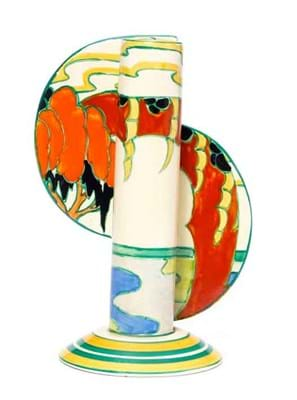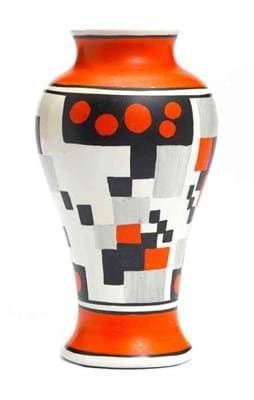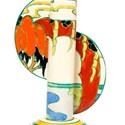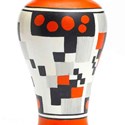Over a relatively short period of time (less than two decades) the Swiss, Scottish-based oil industrialist had put together a top class assemblage.
Using what he termed his BRCV principals (Beauty, Rarity, Condition and Value), he'd "applied museum standards" to the finest examples of the Staffordshire designer's best work. The result was a small select gathering of just over 100 pieces of the most striking and rarest patterns and the most successful shapes. Plainly enamoured with the pottery, he'd also gone on to crystalise his holdings in The Best of Clarice Cliff, an assessment of her work illustrated with many of the pieces from his collection. Of course, such a rapidly acquired enthusiasm doesn't come cheap. Mr Guatelli wanted the best and he'd been prepared to pay top dollar to acquire it. He had brought mostly via the specialist trade, who in turn had acquired these pieces in specialist Clarice auctions.
But dispersing a single-owner collection at auction can sometimes prove a different story - particularly when a major buyer turns vendor as Mr Guatelli did when he offered his collection at Bonhams (20/12% buyer's premium) on March 18.
Mr Guatelli had been a major force in driving values for the best Clarice Cliff wares in what is a relatively small buying pool. This was not a collection that took in the more standard, middle-of-the-road Clarice that is within the range of a broader market.
Market test
Add to all this a sense that Clarice values in 2009 are not what they were a decade or so earlier and this was a test of the top of the market.
There was plenty of pre-sale publicity. Bonhams promoted the collection taking a selection of the pieces to their New York rooms, where Eric Knowles gave a lecture to enthuse the American market. Come sale day, the turnout looked reasonable at around 50 people, but did the audience include the next Guatelli who would step up to the plate?
In total, approximately 60 per cent of the content found buyers to net £180,480, selling to a mix of bidders in the room and buyers from Florida, Australia, Switzerland and South Africa via the phone. But the 39 lots that failed included many of the most expensive wares. And for the 64 lots that did change hands, more were selling at the low end or just under estimate than over. Significantly, failures included eight of the 11 lots in the rare Sunspots design, a field where, with only 20 known pieces, Guatelli had cornered the market.
The failures included a shape 358 vase he had bought at CSK in October 2006 for £17,000 that was one of two examples unsold here with low estimates of £7000. In the event, it was Red Café rather than Sunspots that came out on top. Of the four lots in this pattern in Guatelli's collection, three sold.
Two of them, a 9in (23cm) high Meiping shape vase and a 71/2in (19cm) high triangular section vase led proceedings, selling under estimate at £7500 apiece. The third entry, a 71/2in (19cm) high vase of tapering stepped outline realised £6500, just inside the guide.
Another Red Café triangular section vase, failed at £7000. With no provenance details in the catalogue it is difficult to make price comparisons, but one assumes at least some estimates were pitched well below the prices Mr Guatelli had paid.
But - as the Sunspots vase suggests - it seems many were still too high for today's collectors.
This was reinforced by apparently greater interest in buying up to the £2000- 3000 mark, which is the more natural ceiling of most Clarice collectors. Indeed, at this level one even saw the odd bidding skirmish, as when an 8in (20cm) high vase shown here (shape 464) decorated in the Solitude pattern, guided at £2500-3500, was contested by a phone, a commission bid and dealer Andrew Muir to £4000, or the rare 21/2in (6.5cm) high miniature vase, painted with the Green House pattern estimated at £700-900, which two bidders grappled to £2200. Another strong price came when a Stamford shape part tea-for-two, decorated with the appliqué Red Tree pattern overtook a £2000-3000 estimate to sell for £5800 after a battle between a phone underbidder and a lady seated in the front row.
Even when things sold below predictions prices might not always have been that low. As Bonhams' director of design, Mark Oliver, noted: "Our estimates were as punchy as they could have been," and given that Clarice's stylish inter-War designs are not in the same financial league as top French Deco, he observed: "The prices are right up there in terms of British ceramics."
Bonhams said Sevi Guatelli was pleased with the result in the current market conditions and the unsolds from the sale will be re-offered at the appropriate time.








